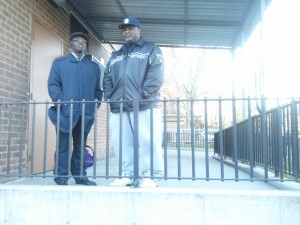
Public housing residents charge patrols are too aggressive
Tyrone “Big Ty” Saylor has had problems with his vision since police sprayed him with Mace, after they handcuffed and arrested him last fall.
Saylor, a resident of the Mott Haven Houses, says he did nothing wrong. According to his friend John Johnson, the Resident Leader at the public housing complex, he was guilty of being too big. Johnson says he heard the officer who arrested him say Saylor was “big and intimidating.
“Residents feel like they’re being targeted and harassed in their own homes,” said Johnson, who was arrested along with Saylor.
Many of their South Bronx neighbors echo that sentiment. They charge that police who patrol New York Housing Authority buildings are overly-aggressive and that they single out people of color for unnecessary questioning and arrests.
“How can you trespass where you live?” asked Danny Barber, a resident leader at the Andrew Jackson Houses. An officer once told him he couldn’t sit outside his building because someone might discharge a firearm. Barber said he felt like a prisoner in his own home.
Similar complaints around the city have become the basis of a lawsuit filed in federal district court in Manhattan by the NAACP Legal Defense Fund, the Legal Aid Society and the law firm Paul, Weiss in January, 2010.
In an attempt to reduce tension between police and residents, the NYPD produced new guidelines and provided an hour-long training workshop for officers working in public housing. Representatives of residents joined police to form the Safety and Security Task Force and to produce the rules.
Since then, the NYPD has tried to get the suit dismissed, saying the changes have addressed the issues. But NACCP attorney Johanna Steinberg says these steps alone are not enough to erase the entrenched police practices that caused violations.
The lawsuit charges that residents of public housing and their guests are questioned and arrested without any basis for suspicion. It focuses on so-called “vertical sweeps” that establish checkpoints in and around NYCHA buildings where people are stopped and questioned. It says police make three times as many stops or arrests in public housing than in surrounding areas with similar rates of crime.
Johnson says what happened in September when police took him and Saylor away in handcuffs is typical. The men were attending a Repass—a memorial service—at the Mott Haven Houses when a police officer came to the door and asked who was in charge. When Johnson appeared and asked her if there was a problem, she told him, “When you people get together, bad things happen.”
Barber says he’s encountered the same attitude toward residents of public housing. At a meeting, a police captain told him, “Nothing good comes from the projects,” Barber said.
Though Johnson was released after a few hours, Saylor had to stay overnight, causing him to miss work and a day’s pay. He was initially charged with assaulting an officer, obstruction of justice and disorderly conduct. The first two charges were dropped, and he was told he’d only have to do a day of community service on the disorderly conduct charge. “I’m not taking that,” he said. “That says I’m guilty of something I didn’t do.”
Many public housing residents recall a time when the relationship between residents and law enforcement was not so strained. They believe the problems started soon after the 1994 merger of the Housing Authority Police Department and the NYPD.
Before the merger community police officers were typically assigned to one housing development. Today, police with little knowledge of the communities they patrol make many of the disputed arrests.
“The police officers are not familiar with the neighborhood and the people, and they automatically assume everyone is a criminal,” says Johnson, who still remembers the beat officer who patrolled his area when he was growing up–Officer Watts.
He says Watts came to community meetings and knew everyone. “If you did something wrong he would put you in your place. Tell your parents. He was a strong disciplinarian, but there was as a level of respect.”
When the administration of Mayor Rudolph Giuliani merged the two police forces, the NYPD also adopted a new policy called zero tolerance policing, which focused on low- level misdemeanors like trespassing, disorderly conduct and possession of marijuana. The strategy was to target small offenses in order to prevent more serious, violent crimes.
Gloria Cruz, who heads the Mott Haven-based Bronx chapter of New Yorkers Against Gun Violence, believes that strategy was effective. While she says she understands the criticism of the police, she believes their tactics have “been successful in getting guns off the streets.”
Cruz defends the New York approach even though her son was once arrested for sitting on the stairwell of their building. When an officer asked him why he was there, he responded, “Because I feel like it. I can’t sleep.” The officer thought her son was “getting smart with him,” said Cruz, so he “was arrested for no reason.”
She added, though, “He brought the conflict on, because he didn’t just talk to them and show respect.”
Cruz took a 14-week training course for civilians and studied how police officers are trained. “I was able to see what they saw and learned a whole different side,” she said.
Barber also emphasizes that he doesn’t want to stereotype all police officers—just as, he says, he doesn’t want them to stereotype public housing residents.

[…] guys in the Mott Haven Houses recently decided they’d had enough and spoke to the papers about how one of them had been handcuffed and then maced, all for “trespassing” in his […]